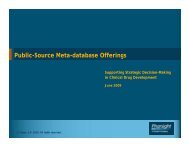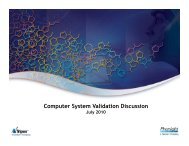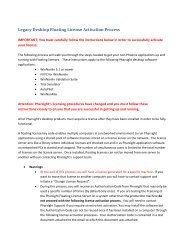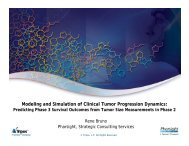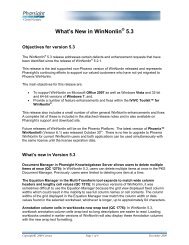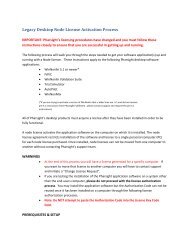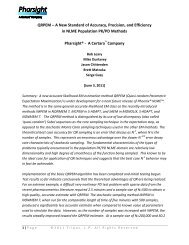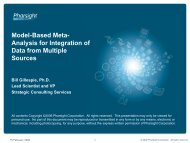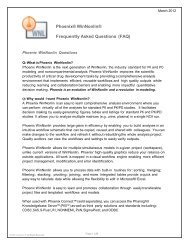What's New in Pharsight Knowledgebase Server™
What's New in Pharsight Knowledgebase Server™
What's New in Pharsight Knowledgebase Server™
Create successful ePaper yourself
Turn your PDF publications into a flip-book with our unique Google optimized e-Paper software.
<strong>Pharsight</strong>® <strong>Knowledgebase</strong> Server<br />
What’s <strong>New</strong> <strong>in</strong> <strong>Pharsight</strong> ® <strong>Knowledgebase</strong> Server<br />
Table of Contents<br />
Summary ............................................................................................................................................... 1<br />
What’s <strong>New</strong> <strong>in</strong> PKS 4.0 .................................................................................................................... 3<br />
Web User Interface Enhancements ................................................................................................... 3<br />
Study Views ...................................................................................................................................... 5<br />
CDISC Export – Import and Improved Data Transfer ...................................................................... 6<br />
Introduction of Study Objects ........................................................................................................... 6<br />
Introduction of Custom Scenario Attributes ..................................................................................... 7<br />
PKS Data Explorer – Configurable Data M<strong>in</strong><strong>in</strong>g Capabilities ......................................................... 9<br />
LDAP Authentication ..................................................................................................................... 10<br />
Control of Number of Licensed Users ............................................................................................ 10<br />
Customizable Fields to Identify Global Library Objects ................................................................ 10<br />
Preferred Field Labels ..................................................................................................................... 11<br />
What’s <strong>New</strong> <strong>in</strong> PKS 4.0.1 ............................................................................................................... 12<br />
What’s <strong>New</strong> <strong>in</strong> PKS 4.0.2 ............................................................................................................... 12<br />
Additional platform support ............................................................................................................ 12<br />
<strong>New</strong> features and fixed defects ....................................................................................................... 12<br />
What’s <strong>New</strong> <strong>in</strong> PKS 4.0.3 ............................................................................................................... 12<br />
Supported Systems and Environments ............................................................................................ 12<br />
Study View Page Improvements ..................................................................................................... 12<br />
Security feature ............................................................................................................................... 13<br />
Summary<br />
<strong>Pharsight</strong> ® <strong>Knowledgebase</strong> Server 4 is a major update of the previously released PKS 3.x versions.<br />
The ma<strong>in</strong> purpose of this major release is to provide a version of PKS that is compatible with releases<br />
of <strong>Pharsight</strong>’s new Phoenix-based product l<strong>in</strong>e, for example, Phoenix W<strong>in</strong>Nonl<strong>in</strong> ® and Phoenix<br />
Connect. In addition, certa<strong>in</strong> enhancements based on customer feedback have been implemented to<br />
further improve the usability and the value of the product, and a number of bugs that were discovered<br />
<strong>in</strong> previous releases were fixed.<br />
Copyright © 2009-2011 Tripos L.P.
<strong>Pharsight</strong> ® <strong>Knowledgebase</strong> Server 4.0<br />
For a smooth migration, PKS 4.x is backwards compatible with W<strong>in</strong>Nonl<strong>in</strong> 5.2.1 and 5.1.1, PKS<br />
Reporter 1.3.1, PKS Clients 3.1 and PKS Office Clients 3.1, and W<strong>in</strong>Nonl<strong>in</strong> AutoPilot 1.2.1 and 1.1.2.<br />
This document summarizes the major enhancements of PKS 4.0 and the subsequent ma<strong>in</strong>tenance<br />
releases. Note that some of the new features are only available when PKS is used with Phoenix<br />
Connect and Phoenix W<strong>in</strong>Nonl<strong>in</strong>. See also the Release Notes document for more details on PKS 4.0.<br />
Page 2 of 13
<strong>Pharsight</strong> ® <strong>Knowledgebase</strong> Server 4.0<br />
What’s <strong>New</strong> <strong>in</strong> PKS 4.0<br />
Web User Interface Enhancements<br />
The layout of the Web browser <strong>in</strong>terface has be redesigned to allow for better and faster navigation.<br />
Studies and study-related objects are displayed <strong>in</strong> a study tree with drop-down menus that allow<br />
execution of tasks right <strong>in</strong> the tree view.<br />
Page 3 of 13
<strong>Pharsight</strong> ® <strong>Knowledgebase</strong> Server 4.0<br />
Additional search and filter options allow faster drill down to the wanted <strong>in</strong>formation and improve<br />
efficiency.<br />
Page 4 of 13
<strong>Pharsight</strong> ® <strong>Knowledgebase</strong> Server 4.0<br />
Study Views<br />
Note that Study Views can only be used for analyses with Phoenix Connect and Phoenix W<strong>in</strong>Nonl<strong>in</strong>.<br />
Study Views are used to prepare the data for use with Phoenix W<strong>in</strong>Nonl<strong>in</strong>. They allow the user to<br />
comb<strong>in</strong>e data from several studies and to selectively <strong>in</strong>clude data to create a ‘view’ <strong>in</strong>to PKS. This<br />
view can be downloaded <strong>in</strong>to Phoenix Connect or Phoenix W<strong>in</strong>Nonl<strong>in</strong> for analysis and report<strong>in</strong>g. The<br />
view remembers the sources of the data (i.e., there is an “active l<strong>in</strong>k”), so that if any of the data sources<br />
is updated, the view will use the new data.<br />
Page 5 of 13
<strong>Pharsight</strong> ® <strong>Knowledgebase</strong> Server 4.0<br />
CDISC Export – Import and Improved Data Transfer<br />
PKS 4.0 has a built-<strong>in</strong> SDTM export feature. The data of a selected study or scenario can be exported<br />
<strong>in</strong>to a set of files <strong>in</strong> SAS Transport format (.xpt files) that represent the SDTM doma<strong>in</strong>s DM (for<br />
general demographics), SC (for additional subject characteristics), EX (for dos<strong>in</strong>g data), PC (for PK<br />
concentrations), and PP (for PK Parameters, available when export<strong>in</strong>g data from a scenario). The user<br />
can use predef<strong>in</strong>ed maps or <strong>in</strong>teractively determ<strong>in</strong>e the mapp<strong>in</strong>g of PKS variables to the required<br />
SDTM variables. The content and format of these files follow the SDTM standard as def<strong>in</strong>ed by the<br />
CDISC organization. All created files are compressed and saved as a “.zip” file. Note that because of<br />
SDTM requirements limitations may apply or data preparation may be required before a successful and<br />
complete export can be executed. This first implementation of a CDISC Export assumes that the data<br />
structure <strong>in</strong> PKS resembles to a certa<strong>in</strong> degree the required SDTM data structure.<br />
<strong>Pharsight</strong> offers a PKS Connector to import SDTM formatted data <strong>in</strong>to PKS. This connector will be<br />
built to order based on a time-and-materials contract by our Deployment Services Group.<br />
PKS 4.0 provides a simple feature to export a complete study from one PKS <strong>in</strong>stance and save the<br />
content <strong>in</strong> a compressed file. The result<strong>in</strong>g “.zip” file can be transferred and imported <strong>in</strong>to another<br />
<strong>in</strong>stance of PKS 4.0. Note that this feature is only available when PKS 4.0 is deployed us<strong>in</strong>g Oracle<br />
10g or higher.<br />
Introduction of Study Objects<br />
PKS 4.0 allows users to add objects to studies rather than just to the global library. This allows for<br />
better organization of objects by l<strong>in</strong>k<strong>in</strong>g objects directly to the appropriate study.<br />
Page 6 of 13
<strong>Pharsight</strong> ® <strong>Knowledgebase</strong> Server 4.0<br />
Introduction of Custom Scenario Attributes<br />
PSK 4.0 allows users to def<strong>in</strong>e Custom Attributes not only for studies, but for scenarios as well.<br />
Custom Attributes are managed <strong>in</strong> the Configuration tab of the Web browser <strong>in</strong>terface.<br />
Page 7 of 13
<strong>Pharsight</strong> ® <strong>Knowledgebase</strong> Server 4.0<br />
Once Custom Attributes are set for scenarios or studies, these attributes can be used <strong>in</strong> the filter for a<br />
targeted search, e.g., <strong>in</strong> this example the scenario Base_1 of the study Carterolol is filtered out based<br />
on the Custom Attribute “Use for PHX”.<br />
Page 8 of 13
<strong>Pharsight</strong> ® <strong>Knowledgebase</strong> Server 4.0<br />
PKS Data Explorer – Configurable Data M<strong>in</strong><strong>in</strong>g Capabilities<br />
The PKS Data Explorer is a configurable data m<strong>in</strong><strong>in</strong>g tool that allows users to exam<strong>in</strong>e data across all<br />
studies and study subsets based on criteria <strong>in</strong> the data. In contrast to the Query Tool, the Data Explorer<br />
does not require that studies be pre-selected to be exam<strong>in</strong>ed. In fact, <strong>in</strong> the Data Explorer, the user<br />
def<strong>in</strong>es selection criteria for the data and the tool searches across all studies to extract data that match.<br />
In addition, the Data Explorer provides a few simple summary statistics across the extracted data.<br />
Data Explorer is based on so-called ‘data m<strong>in</strong>es’, a PL/SQL procedure which is executed to extract the<br />
data from the database. This procedure has to follow certa<strong>in</strong> restrictions so it can be embedded <strong>in</strong>to the<br />
exist<strong>in</strong>g <strong>in</strong>frastructure for data m<strong>in</strong>es. In addition to writ<strong>in</strong>g this procedure, the data m<strong>in</strong>es need to be<br />
deployed. These steps are typically performed by a database adm<strong>in</strong>istrator or they can be part of the<br />
deployment of PKS by <strong>Pharsight</strong> or the customer’s IT group. Once the data m<strong>in</strong>es are <strong>in</strong> place, they<br />
can be easily used by any user by just specify<strong>in</strong>g the desired output and criteria.<br />
The above data m<strong>in</strong>e will extract the Race and Gender <strong>in</strong>formation across all studies <strong>in</strong> the database<br />
and create the listed statistics for the Age parameter of the subjects (see below).<br />
Page 9 of 13
<strong>Pharsight</strong> ® <strong>Knowledgebase</strong> Server 4.0<br />
Row # RACE SEX Parameter Count Average M<strong>in</strong> Max<br />
1 AGE 13 55.462 22 69<br />
2 ASIAN F AGE 13 30.385 21 39<br />
3 ASIAN M AGE 15 34.533 20 56<br />
4 CAUCASION F AGE 5 30.2 23 37<br />
5 CAUCASION M AGE 9 34.444 20 58<br />
By default, PKS is deployed with two work<strong>in</strong>g data m<strong>in</strong>es (and the static test example that is used for<br />
demonstration and test purposes). Additional examples that can be deployed ‘as is’ and that can also be<br />
used as start<strong>in</strong>g po<strong>in</strong>ts for custom data m<strong>in</strong>es are <strong>in</strong>cluded with the PKS 4.0 product.<br />
LDAP Authentication<br />
PKS 4.0 supports external authentication aga<strong>in</strong>st an LDAP (Lightweight Directory Access Protocol)<br />
server. This feature provides users with the ability to use the same username and password as used for<br />
other systems with<strong>in</strong> their corporate network.<br />
Control of Number of Licensed Users<br />
In PKS 4.0 the number of licensed users is controlled by a licens<strong>in</strong>g feature. A system adm<strong>in</strong>istrator<br />
needs to set the number of active users, i.e. users that have any access to studies or scenarios, and the<br />
type of access <strong>in</strong> the configuration module of PKS.<br />
Customizable Fields to Identify Global Library Objects<br />
Library objects that are not associated with a particular study or scenario are added to the “global”<br />
library. PKS stores specific metadata about each library object, <strong>in</strong>clud<strong>in</strong>g name, type, and version. In<br />
PKS 4.0, additional key and non-key fields can be used to <strong>in</strong>clude more user-def<strong>in</strong>ed metadata that can<br />
be configured and used to organize, filter, and group library objects. The column labels for these fields<br />
are def<strong>in</strong>ed through the “Preferred Field Labels” feature (see next section).<br />
Page 10 of 13
<strong>Pharsight</strong> ® <strong>Knowledgebase</strong> Server 4.0<br />
Preferred Field Labels<br />
PKS 4.0 allows customers to use so-called Preferred Field Labels to change the name of the fields <strong>in</strong><br />
the data results. The default name is what currently displays <strong>in</strong> PKS.<br />
Page 11 of 13
<strong>Pharsight</strong> ® <strong>Knowledgebase</strong> Server 4.0<br />
What’s <strong>New</strong> <strong>in</strong> PKS 4.0.1<br />
PKS 4.0.1 is a ma<strong>in</strong>tenance release to address a performance problem with a large number of studies<br />
and with large studies. In addition, PKS 4.0.1 supports lock<strong>in</strong>g and unlock<strong>in</strong>g of library objects from<br />
desktop client software such as the PKS browser <strong>in</strong> Phoenix Connect.<br />
What’s <strong>New</strong> <strong>in</strong> PKS 4.0.2<br />
Additional platform support<br />
PKS was tested on additional Operat<strong>in</strong>g Systems W<strong>in</strong>dows Server 2008 and 64-bit Red Hat L<strong>in</strong>ux<br />
Enterprise for the server (for the database and middle tier server) and W<strong>in</strong>dows 7 (32-/64-bit) and<br />
Citrix on W<strong>in</strong>dows Server 2008 for the desktop operat<strong>in</strong>g system. In addition, an exist<strong>in</strong>g defect<br />
related to Oracle 11g R2 was fixed.<br />
<strong>New</strong> features and fixed defects<br />
The follow<strong>in</strong>g new features and bug fixes were implemented:<br />
• Added the ability to upload multiple study objects at once<br />
• PKS Adm<strong>in</strong>istrator can execute SQL scripts aga<strong>in</strong>st the database from the Web Browser user<br />
<strong>in</strong>terface<br />
• PKS Adm<strong>in</strong>istrator can add a message to the log<strong>in</strong> screen to pass <strong>in</strong>formation to users<br />
• Added error check to prevent users from us<strong>in</strong>g reserved column names when add<strong>in</strong>g and nam<strong>in</strong>g<br />
custom columns<br />
• Fixed a few display issues <strong>in</strong> the Web Browser<br />
• Fixed issue with CDISC export <strong>in</strong> a multiple <strong>in</strong>stance environment<br />
• Fixed several issues with access rights and electronic signatures<br />
What’s <strong>New</strong> <strong>in</strong> PKS 4.0.3<br />
Supported Systems and Environments<br />
Support for Oracle RAC (Real Application Cluster): The PKS database can now be deployed <strong>in</strong> an<br />
Oracle RAC environment and use the benefits of Oracle RAC.<br />
Support of Microsoft Excel “.xlsx” files for data connectors: PKS has been modified to allow for<br />
the implementation of support for .xlsx files <strong>in</strong> PKS Data Connectors for Excel.<br />
Study View Page Improvements<br />
Multiple page view for the content on the Studies and Library tabs: A new Navigation Bar has<br />
been added to the Studies and Library tabs. This Navigator Bar has a default page size of 100 items,<br />
and is configurable via the Page Size field. A user configuration sett<strong>in</strong>g located <strong>in</strong> the User Options for<br />
the logged <strong>in</strong> user is preserved across sessions. The user sett<strong>in</strong>gs also allow the logged <strong>in</strong> user to def<strong>in</strong>e<br />
which tab is selected for display automatically at log<strong>in</strong>. All display changes will be enabled at the next<br />
log<strong>in</strong>.<br />
Improved performance of study view for large number of studies: Studies tab Load and Refresh<br />
times have been improved for PKS 4.0.3.<br />
Page 12 of 13
<strong>Pharsight</strong> ® <strong>Knowledgebase</strong> Server 4.0<br />
Improved order of study child nodes: The content on the Studies tab is now ordered <strong>in</strong> the follow<strong>in</strong>g<br />
fashion for Study Objects, Study Views and Scenario Nodes:<br />
• Primary: by <strong>in</strong>itial letter account<strong>in</strong>g for capitalization<br />
• Secondarily: by the parent object name<br />
Security feature<br />
PKS Web browser <strong>in</strong>terface improvement: The PKS Web browser log<strong>in</strong> component has been<br />
modified to disallow “auto complete” for username and password even if AutoComplete is enabled <strong>in</strong><br />
the Web browser.<br />
Page 13 of 13



